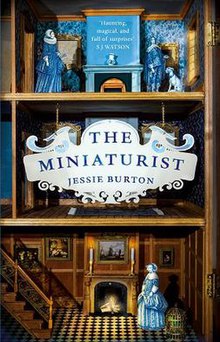Disclaimer: If you make a purchase through links in this blog, I may earn a commission from the sellers, but that does not impact the content of these posts or the cost to you as a consumer.
It is autumn in 1686, and eighteen-year-old Petronella (Nella) Oortman arrives at the grand house of her wealthy merchant husband in Amsterdam. Though they are married, they do not know each other. The marriage is one arranged for practical reasons - Nella's late father squandered her family's money, and so the marriage ensures survival.
Nella, a young woman, still innocent to the ways of the world in many ways, enters into a darker and more violently passionate world. As we follow this character throughout the novel, we see her discover the darkness that people will embrace and endure for the sake of love, for the sake of being true to themselves. Even the new home to which she comes to live is darker and more exotic than surroundings she has known thus far in her life.
Understandably, Nella does not slip easily into her role in her new home. In fact, her unease is compounded by a husband, Johannes Brandt, who is either absent from the household or who seems to be wholly uninterested in any intimacy with his new wife. And, there is his sister, Marin, who is secretive and tense, perhaps even hostile. It is a home in which secrets are kept, and Nella, at first, is unsure of her place. At the beginning of the novel, the reader can feel how lonely she might have felt in such a situation.
Finally, Johannes reaches for the curtains, and with an extravagant flourish, he pulls them aside. The women gasp. The inside of the cabinet is revealed, divided into nine sections, some lined with gold-embossed wallpaper and others with wooden panels.
- from The Miniaturist, Jessie Burton
Johannes gifts his new wife a cabinet model of the home that they share, a cabinet created by the miniaturist of the title. Throughout the story, the miniaturist is ever present and yet unseen. The figures and models that Nella receives from the eponymous craftswoman of the novel seem to be conveying messages to the recipient. As Nella ponders what it is the miniaturist is trying to tell her, she considers that this stranger might be sending warnings, has some supernatural ability to see into their lives, or perhaps even holds the fate of the household in her hands!
From my reading, secrets are a major theme of this story. The secrets that exist between the characters of the novel, the secrets that they keep from those outside of their house, and the reasons that they keep those secrets. Perhaps, it would be more correct to say that it is not so much the theme of secrecy, but the secrets that people feel a need to keep from the world when they dare to be true to themselves. When they dare to explore and embrace relationships that they know the world would condemn them for. This is a novel that explores the darkness that can come with love, not because of the love itself, but for the world in which that love exists.
Amsterdam of the late seventeenth century is drawn very well, the reader can tell that Jessie Burton has done her research there. Which isn't to say that the description of the time and place is done gratuitously, it isn't. Quite the opposite - the reader feels effortlessly taken away to that time. However, the characters could have, in my humble opinion, done with a little more fleshing out. But, I think, that is my only niggle.
If you are at all intrigued, and would like to purchase the book, you can do so at bookshop.org who support independent bookshops.
Also, if you enjoyed this piece, or anything else that I have written, please do consider following/supporting me over at ko-fi - it keeps me blogging and writing.

No comments:
Post a Comment